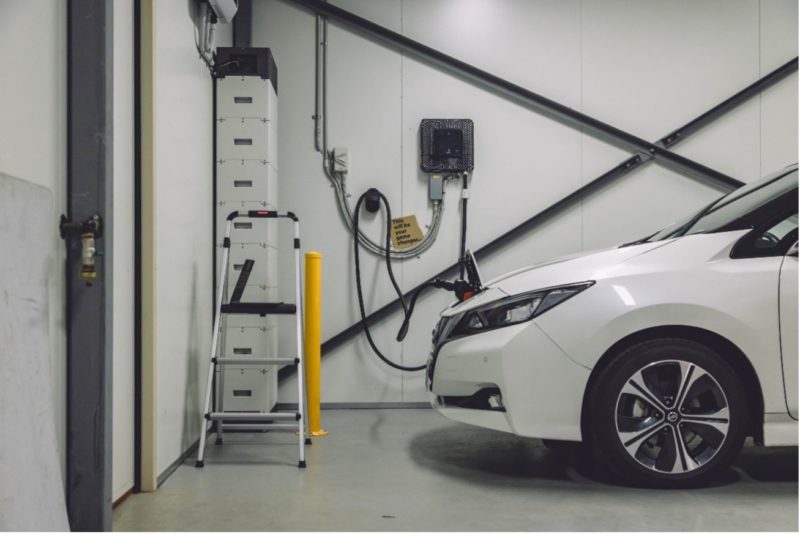A group of 16 electric cars plugged into charging stations in Canberra have given a world-first demonstration of their ability to keep the lights on by feeding power back into the grid during a major grid emergency in February.
More than 90,000 customers lost power for more than an hour in February in Victoria when fierce storms tore down some transmission lines and – to the surprise of the market operator – caused the giant Loy Yang A coal fired generator to trip.
Generators and big batteries responded by injecting power into the grid within seconds, helping to stabilise frequency levels within acceptable bounds and preventing a wider outage. At the same time, 16 Nissan Leafs also helped by feeding power back into the grid more than 500 kms away in Canberra, proving their ability to respond to major grid events.
According to Dr Bjorn Sturmberg from the Australian National University, this is the first time in the world that this type of vehicle-to-grid response has been demonstrated in an emergency.
“It shows electric vehicles can provide the backup we need in an emergency like this,” he says.
“We have a fleet of 51 EVs across Canberra that monitor the grid whenever they’re plugged in and can quickly inject short bursts of power to rebalance the system if the national grid rapidly loses power. They’re essentially big batteries on wheels.
“The blackout in February – caused by major storms in Melbourne — was the first real-world test of our vehicles and chargers. We now know a vehicle-to-grid system can work.”
The 51 Nissan Leafs are part of a lengthy trial in the ACT that has been proving the viability of V2G technology – one of several trials that have been going on around the country, including in South Australia at Flinders University and elsewhere.

At the time of the February event in Victoria, 16 of the ACT-based EVs were plugged in at properties across Canberra. Four were charging, and were able to quickly reverse course and discharge into the grid, while 12 that were idle were able to respond and start discharging within seconds.
Dr Sturmberg said he had been waiting a long time for such an event to occur to prove his theory. “It worked,” he told The Driven in the latest episode of The Driven podcast.
“These vehicles quickly stopped charging and within seconds started discharging power into the grid, as they’ve been programmed to do,” Dr Sturmberg said.
The amount they provided was tiny – just 107 kilowatts – but Sturmburg says it is the potential of EVs at scale that is the exciting part of the story.
But he said that if 6,000 enabled EVS had been plugged into the grid at the time, and had stopped charging on a signal, that would have removed the need to cut off the power to the 90,000 customers. (Other customers also lost power, some for days, but those events were caused by damage to local networks caused by fallen trees and local power lines).
Sturmburg says that around 105,000 EVs plugged into the right sort of V2G equipment would be enough to fully cover the backup required for the whole of the ACT and NSW.
The Australian Energy Market Operator has forecast the country will have 21 million EVs on the roads by 2050, and expects EVs and other so-called consumer energy resources will play a significant role in providing the flexible and dispatchable capacity needed to fill the gaps in wind and solar output in the future.
At the moment, the only EVs that can provide this service are Japanese-made Nissan Leafs electric cars and the Mitsubishi Outlander plug in hybrid cars. Both use CHAdeMO charging protocols, but this is gradually being phased out.
All other EVs use CCS2 technology, and by next year this protocol is expected to have V2G technology approved, opening the door for EVs to play a crucial role in the management of grids dominated by wind and solar in decades to come.
“It kind of astounded me that this is the first time as far as I can tell in the world that we’ve had vehicles responding this way,” he says. “And Australia has a long stringy grid that’s exposed to these sorts of vulnerabilities.
However, Sturmberg says there is more work to be done. For a start, the only company providing V2G chargers in Australia is no longer doing so, and new equipment will need to be imported once the protocols are accepted in Australia by the market operator and network companies.
Changes will also be needed in the way charging sessions are managed, Sturmberg says. For instance, charging may have to be delayed for an hour or two after such an event to ensure grid security. EV makers have a role to play in this, and could provide an option for some drivers to override this in an emergency.
“Stopping just 6,000 vehicles charging would have kept the power on for those 90,000 customers whose power was cut on February 13.
“Our results show that vehicle-to-grid can be a powerful contributor to our power system’s security, and that all electric vehicles have an important role to play.”
For more details about this story, please listen to the latest episode of The Driven podcast to be published on Tuesday.

Giles Parkinson is founder and editor of The Driven, and also edits and founded the Renew Economy and One Step Off The Grid web sites. He has been a journalist for nearly 40 years, is a former business and deputy editor of the Australian Financial Review, and owns a Tesla Model 3.

